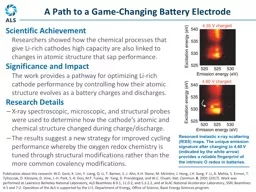PPT-Scientific Achievement Researchers showed how the chemical processes that give Li-rich
Author : briana-ranney | Published Date : 2018-10-30
Significance and Impact The work provides a pathway for optimizing Lirich cathode performance by controlling how their atomic structure evolves as a battery charges
Presentation Embed Code
Download Presentation
Download Presentation The PPT/PDF document "Scientific Achievement Researchers showe..." is the property of its rightful owner. Permission is granted to download and print the materials on this website for personal, non-commercial use only, and to display it on your personal computer provided you do not modify the materials and that you retain all copyright notices contained in the materials. By downloading content from our website, you accept the terms of this agreement.
Scientific Achievement Researchers showed how the chemical processes that give Li-rich: Transcript
Download Rules Of Document
"Scientific Achievement Researchers showed how the chemical processes that give Li-rich"The content belongs to its owner. You may download and print it for personal use, without modification, and keep all copyright notices. By downloading, you agree to these terms.
Related Documents














